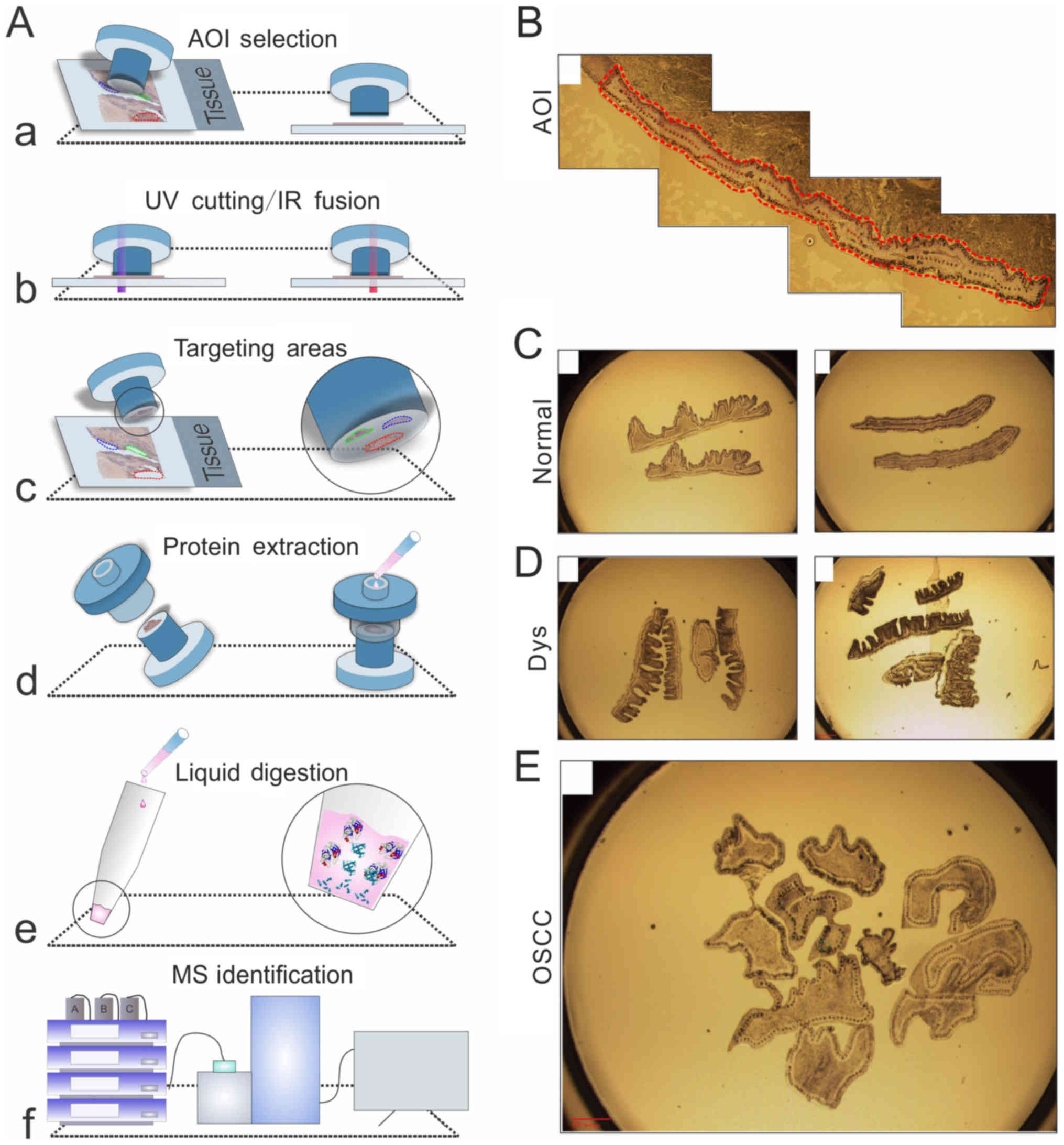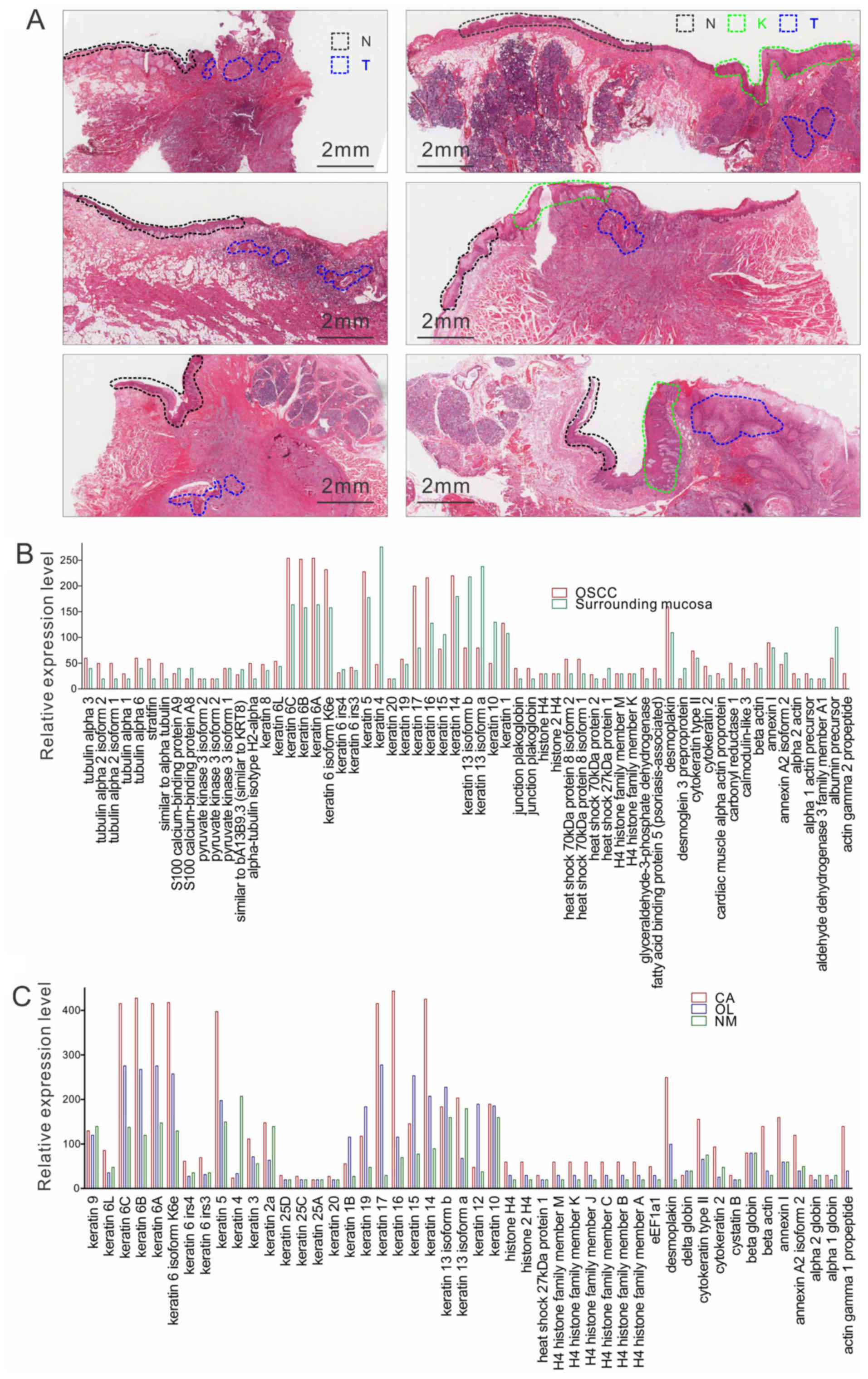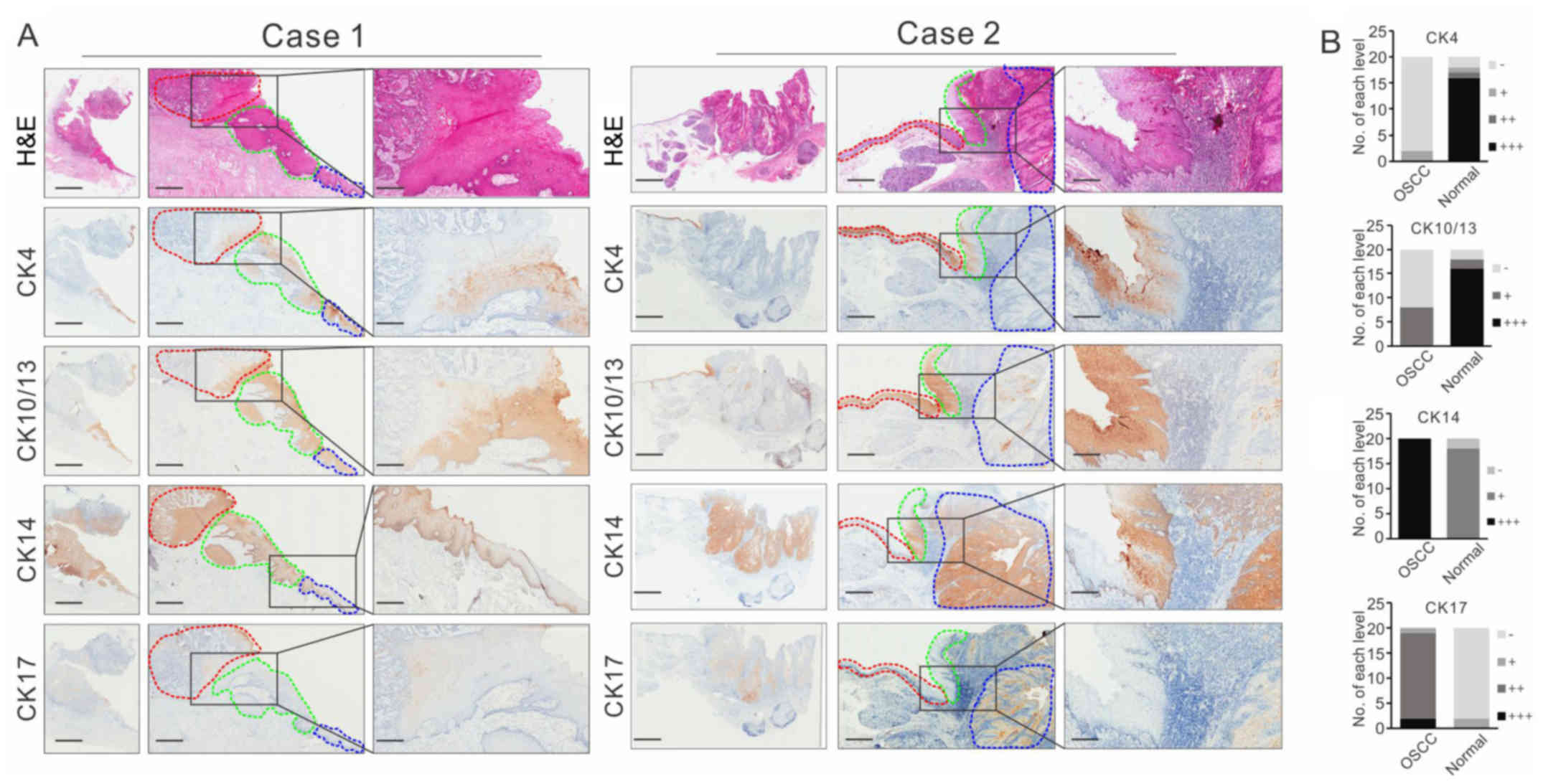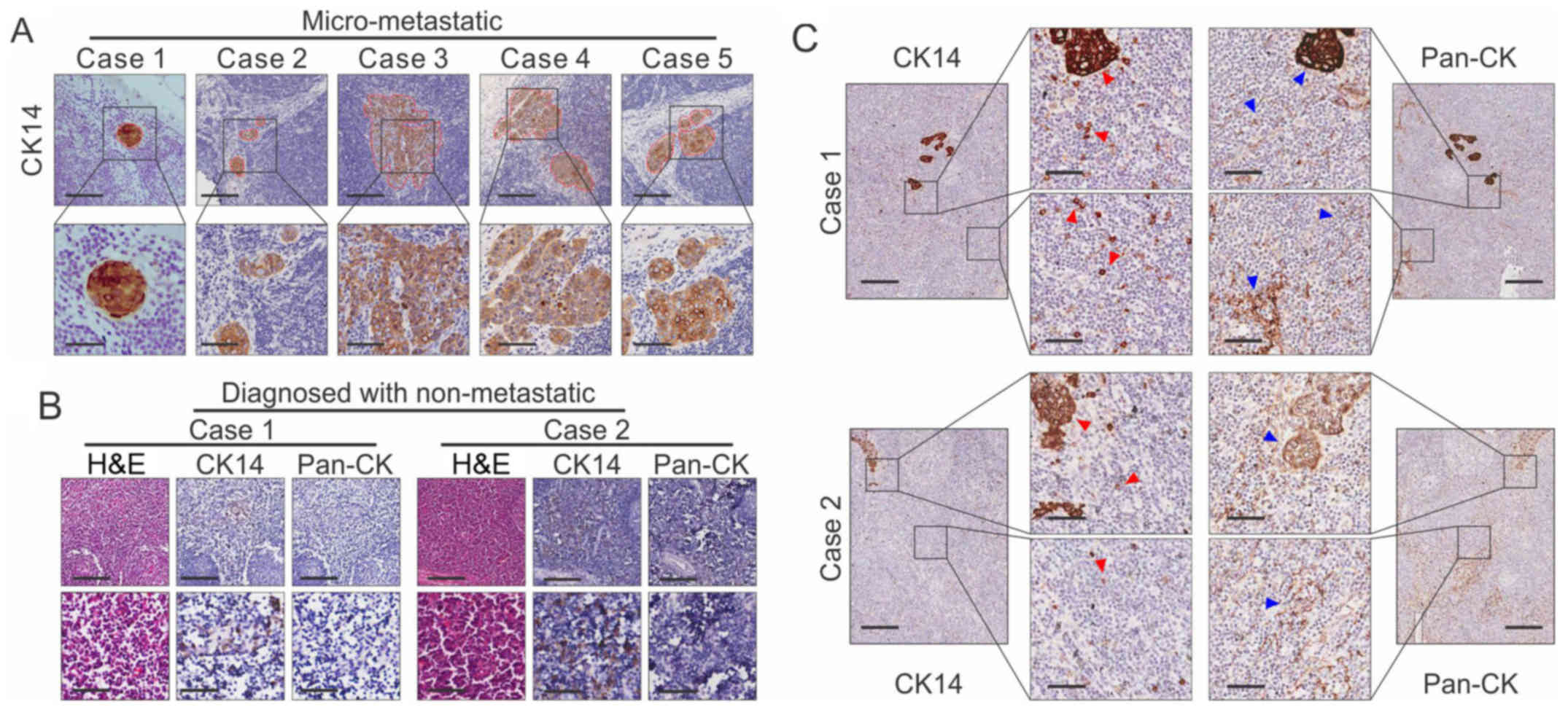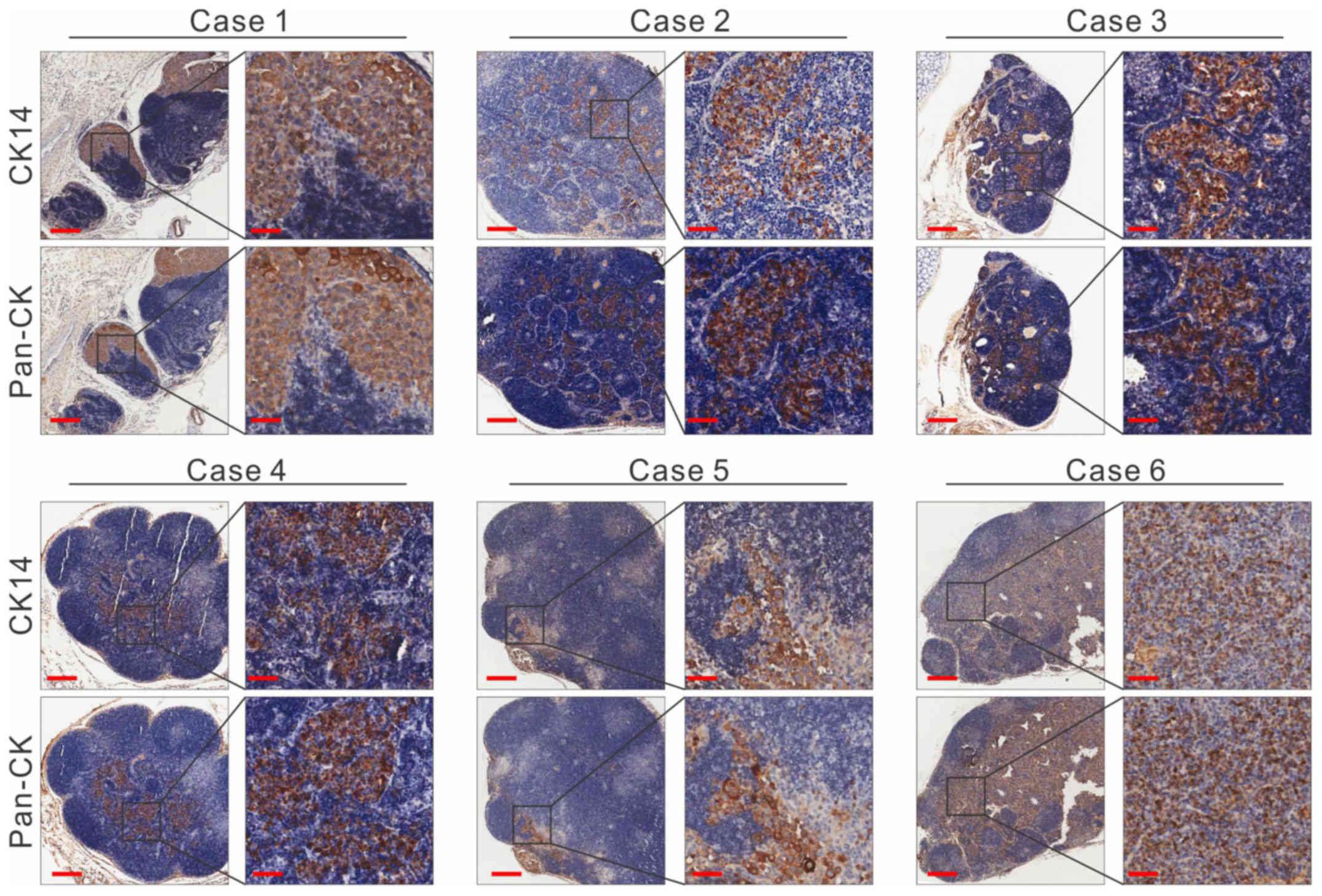|
1
|
Warnakulasuriya S: Global epidemiology of
oral and oropharyngeal cancer. Oral Oncol. 45:309–316. 2009.
View Article : Google Scholar : PubMed/NCBI
|
|
2
|
Chen W, Zheng R, Baade PD, Zhang S, Zeng
H, Bray F, Jemal A, Yu XQ and He J: Cancer statistics in China,
2015. CA Cancer J Clin. 66:115–132. 2016. View Article : Google Scholar : PubMed/NCBI
|
|
3
|
Panzarella V, Pizzo G, Calvino F,
Compilato D, Colella G and Campisi G: Diagnostic delay in oral
squamous cell carcinoma: The role of cognitive and psychological
variables. Int J Oral Sci. 6:39–45. 2014. View Article : Google Scholar : PubMed/NCBI
|
|
4
|
Perez-Ordoñez B, Beauchemin M and Jordan
RC: Molecular biology of squamous cell carcinoma of the head and
neck. J Clin Pathol. 59:445–453. 2006. View Article : Google Scholar : PubMed/NCBI
|
|
5
|
Messadi DV: Diagnostic aids for detection
of oral precancerous conditions. Int J Oral Sci. 5:59–65. 2013.
View Article : Google Scholar : PubMed/NCBI
|
|
6
|
Warnakulasuriya S, Johnson NW and van der
Waal I: Nomenclature and classification of potentially malignant
disorders of the oral mucosa. J Oral Pathol Med. 36:575–580. 2007.
View Article : Google Scholar : PubMed/NCBI
|
|
7
|
Wulfkuhle JD, Liotta LA and Petricoin EF:
Proteomic applications for the early detection of cancer. Nat Rev
Cancer. 3:267–275. 2003. View
Article : Google Scholar : PubMed/NCBI
|
|
8
|
Schaaij-Visser TB, Bremmer JF, Braakhuis
BJ, Heck AJ, Slijper M, van der Waal I and Brakenhoff RH:
Evaluation of cornulin, keratin 4, keratin 13 expression and grade
of dysplasia for predicting malignant progression of oral
leukoplakia. Oral Oncol. 46:123–127. 2010. View Article : Google Scholar : PubMed/NCBI
|
|
9
|
Hood BL, Conrads TP and Veenstra TD: Mass
spectrometric analysis of formalin-fixed paraffin-embedded tissue:
Unlocking the proteome within. Proteomics. 6:4106–4114. 2006.
View Article : Google Scholar : PubMed/NCBI
|
|
10
|
Sprung RW Jr, Brock JW, Tanksley JP, Li M,
Washington MK, Slebos RJ and Liebler DC: Equivalence of protein
inventories obtained from formalin-fixed paraffin-embedded and
frozen tissue in multidimensional liquid chromatography-tandem mass
spectrometry shotgun proteomic analysis. Mol Cell Proteomics.
8:1988–1998. 2009. View Article : Google Scholar : PubMed/NCBI
|
|
11
|
Yuan Y, Hou X, Feng H, Liu R, Xu H, Gong
W, Deng J, Sun C, Gao Y, Peng J, et al: Proteomic identification of
cyclophilin A as a potential biomarker and therapeutic target in
oral submucous fibrosis. Oncotarget. 7:60348–60365. 2016.
View Article : Google Scholar : PubMed/NCBI
|
|
12
|
Espina V, Wulfkuhle JD, Calvert VS,
VanMeter A, Zhou W, Coukos G, Geho DH, Petricoin EF III and Liotta
LA: Laser-capture microdissection. Nat Protoc. 1:586–603. 2006.
View Article : Google Scholar : PubMed/NCBI
|
|
13
|
Merkley MA, Weinberger PM, Jackson LL,
Podolsky RH, Lee JR and Dynan WS: 2D-DIGE proteomic
characterization of head and neck squamous cell carcinoma.
Otolaryngol Head Neck Surg. 141:626–632. 2009. View Article : Google Scholar : PubMed/NCBI
|
|
14
|
Pawar H, Maharudraiah J, Kashyap MK,
Sharma J, Srikanth SM, Choudhary R, Chavan S, Sathe G, Manju HC,
Kumar KV, et al: Downregulation of cornulin in esophageal squamous
cell carcinoma. Acta Histochem. 115:89–99. 2013. View Article : Google Scholar : PubMed/NCBI
|
|
15
|
Shores CG, Yin X, Funkhouser W and
Yarbrough W: Clinical evaluation of a new molecular method for
detection of micrometastases in head and neck squamous cell
carcinoma. Arch Otolaryngol Head Neck Surg. 130:937–942. 2004.
View Article : Google Scholar : PubMed/NCBI
|
|
16
|
Loree TR and Strong EW: Significance of
positive margins in oral cavity squamous carcinoma. Am J Surg.
160:410–414. 1990. View Article : Google Scholar : PubMed/NCBI
|
|
17
|
Cheng A, Cox D and Schmidt BL: Oral
squamous cell carcinoma margin discrepancy after resection and
pathologic processing. J Oral Maxillofac Surg. 66:523–529. 2008.
View Article : Google Scholar : PubMed/NCBI
|
|
18
|
Hosseinpour S, Mashhadiabbas F and Ahsaie
MG: Diagnostic biomarkers in oral verrucous carcinoma: A systematic
review. Pathol Oncol Res. 23:19–32. 2017. View Article : Google Scholar : PubMed/NCBI
|
|
19
|
Tirelli G, Zacchigna S, Biasotto M and
Piovesana M: Open questions and novel concepts in oral cancer
surgery. Eur Arch Otorhinolaryngol. 273:1975–1985. 2016. View Article : Google Scholar : PubMed/NCBI
|
|
20
|
Khanom R, Sakamoto K, Pal SK, Shimada Y,
Morita K, Omura K, Miki Y and Yamaguchi A: Expression of basal cell
keratin 15 and keratin 19 in oral squamous neoplasms represents
diverse pathophysiologies. Histol Histopathol. 27:949–959.
2012.PubMed/NCBI
|
|
21
|
Sakamoto K, Aragaki T, Morita K, Kawachi
H, Kayamori K, Nakanishi S, Omura K, Miki Y, Okada N, Katsube K, et
al: Down-regulation of keratin 4 and keratin 13 expression in oral
squamous cell carcinoma and epithelial dysplasia: A clue for
histopathogenesis. Histopathology. 58:531–542. 2011. View Article : Google Scholar : PubMed/NCBI
|
|
22
|
Ohkura S, Kondoh N, Hada A, Arai M,
Yamazaki Y, Sindoh M, Takahashi M, Matsumoto I and Yamamoto M:
Differential expression of the keratin-4, −13, −14, −17 and
transglutaminase 3 genes during the development of oral squamous
cell carcinoma from leukoplakia. Oral Oncol. 41:607–613. 2005.
View Article : Google Scholar : PubMed/NCBI
|
|
23
|
Nobusawa A, Sano T, Negishi A, Yokoo S and
Oyama T: Immunohistochemical staining patterns of cytokeratins 13,
14, and 17 in oral epithelial dysplasia including orthokeratotic
dysplasia. Pathol Int. 64:20–27. 2014. View Article : Google Scholar : PubMed/NCBI
|
|
24
|
Valach J, Foltan R, Vlk M, Szabo P and
Smetana K Jr: Phenotypic characterization of oral mucosa: What is
normal? J Oral Pathol Med. 46:834–839. 2017. View Article : Google Scholar : PubMed/NCBI
|
|
25
|
Hansson A, Bloor BK, Haig Y, Morgan PR,
Ekstrand J and Grafström RC: Expression of keratins in normal,
immortalized and malignant oral epithelia in organotypic culture.
Oral Oncol. 37:419–430. 2001. View Article : Google Scholar : PubMed/NCBI
|
|
26
|
Ming XY, Fu L, Zhang LY, Qin YR, Cao TT,
Chan KW, Ma S, Xie D and Guan XY: Integrin α7 is a functional
cancer stem cell surface marker in oesophageal squamous cell
carcinoma. Nat Commun. 7:135682016. View Article : Google Scholar : PubMed/NCBI
|
|
27
|
Jacques CM, Pereira AL, Maia V, Cuzzi T
and Ramos-e-Silva M: Expression of cytokeratins 10, 13, 14 and 19
in oral lichen planus. J Oral Sci. 51:355–365. 2009. View Article : Google Scholar : PubMed/NCBI
|
|
28
|
Fay J, Kelehan P, Lambkin H and Schwartz
S: Increased expression of cellular RNA-binding proteins in
HPV-induced neoplasia and cervical cancer. J Med Virol. 81:897–907.
2009. View Article : Google Scholar : PubMed/NCBI
|
|
29
|
Bech R, Otkjaer K, Birkelund S,
Vorup-Jensen T, Agger R, Johansen C, Iversen L, Kragballe K and
Rømer J: Interleukin 20 protein locates to distinct mononuclear
cells in psoriatic skin. Exp Dermatol. 23:349–352. 2014. View Article : Google Scholar : PubMed/NCBI
|
|
30
|
Linskey KR, Gimbel DC, Zukerberg LR,
Duncan LM, Sadow PM and Nazarian RM: BerEp4, cytokeratin 14, and
cytokeratin 17 immunohistochemical staining aid in differentiation
of basaloid squamous cell carcinoma from basal cell carcinoma with
squamous metaplasia. Arch Pathol Lab Med. 137:1591–1598. 2013.
View Article : Google Scholar : PubMed/NCBI
|
|
31
|
Safi AF, Grandoch A, Nickenig HJ, Zöller
JE and Kreppel M: The importance of lymph node ratio for
locoregional recurrence of squamous cell carcinoma of the tongue. J
Craniomaxillofac Surg. 45:1058–1061. 2017. View Article : Google Scholar : PubMed/NCBI
|
|
32
|
Polterauer S, Schwameis R, Grimm C, Macuks
R, Iacoponi S, Zalewski K and Zapardiel I: VULCAN Study
Collaborative Group: Prognostic value of lymph node ratio and
number of positive inguinal nodes in patients with vulvar cancer.
Gynecol Oncol. 147:92–97. 2017. View Article : Google Scholar : PubMed/NCBI
|
|
33
|
Gholami S, Janson L, Worhunsky DJ, Tran
TB, Squires MH III, Jin LX, Spolverato G, Votanopoulos KI, Schmidt
C, Weber SM, et al: Number of lymph nodes removed and survival
after gastric cancer resection: An analysis from the US gastric
cancer collaborative. J Am Coll Surg. 221:291–299. 2015. View Article : Google Scholar : PubMed/NCBI
|
|
34
|
Liang W, He J, Shen Y, Shen J, He Q, Zhang
J, Jiang G, Wang Q, Liu L, Gao S, et al: Impact of examined lymph
node count on precise staging and long-term survival of resected
non-small-cell lung cancer: A population study of the us seer
database and a chinese multi-institutional registry. J Clin Oncol.
35:1162–1170. 2017. View Article : Google Scholar : PubMed/NCBI
|















